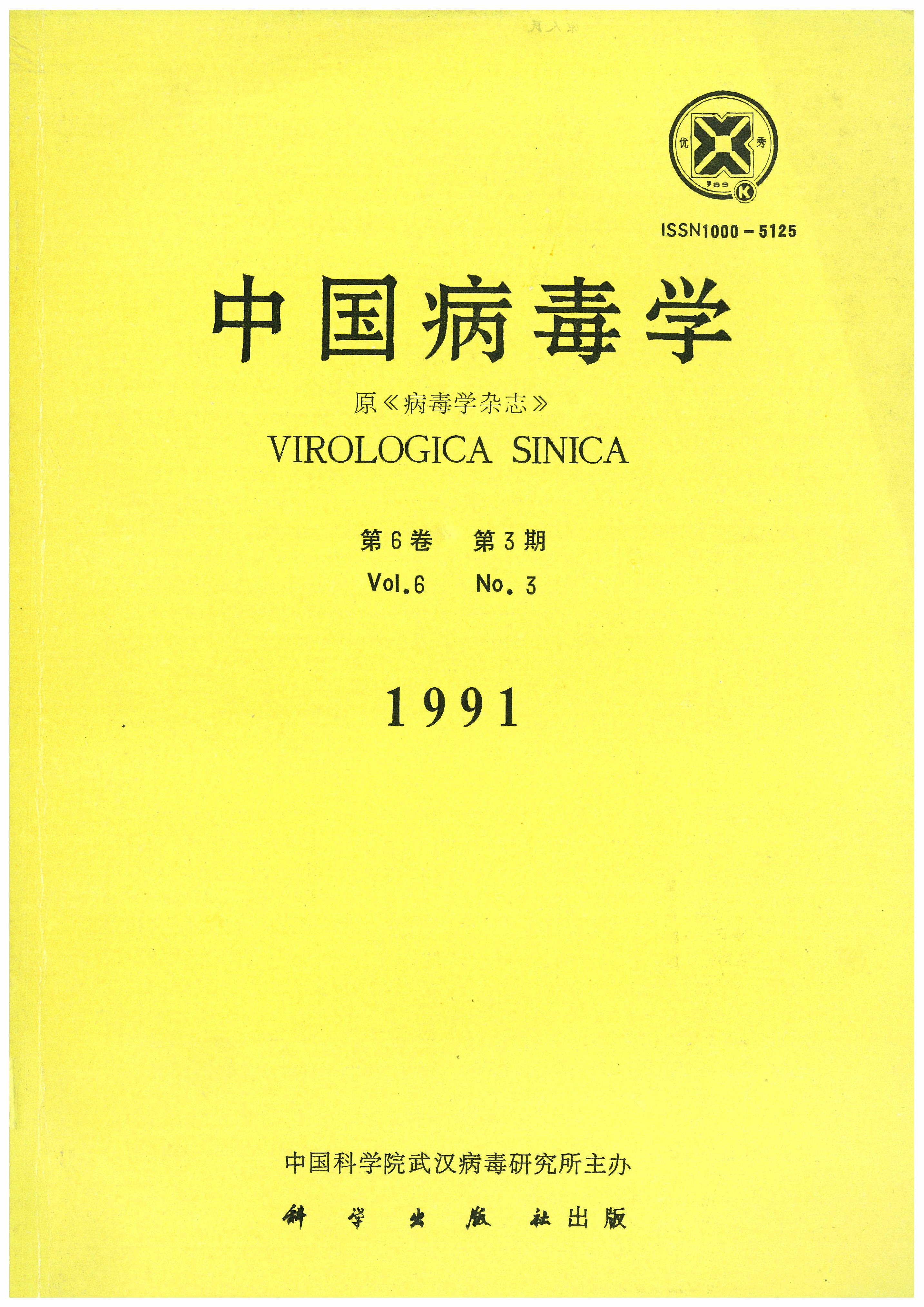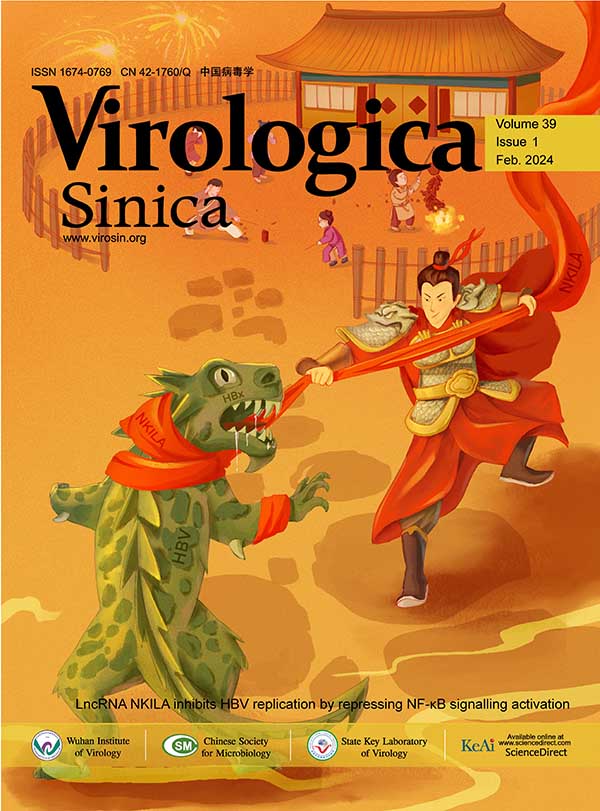We successfully established a system in vitro that HSV-Ⅰ infected human tonsillar lymphocytes. Tonsillar lymphocytes prestimulated with PWM(10μg/ml) were infected by living HSV-Ⅰ, so as to their proliferation and IgG synthesis were abated significantly(P<0.005).In the supernatants, the infective titers ofHSV-Ⅰ were about 10~(3?2)—10~(5?7) TCID_(50)/ml,number of viral antigen positive cells about 3%—8%.We found that some lymphokine and monokine can dampen the inhibition of infection of infectious HSV-Ⅰ Th...
To investigate the role of viral receptor in the initiation of dengue virus infection, viral attachment rates (AR) on Aedes albopictus cell (C6/36), human monocyte-like cell (U937), human T4 (H9),B lymphoblastoid cell(Raji), mouse myeloma cell (SP2/0) and mouse fibroblast cell (L929) were calculated by measuring the residual virus concentration after inoculating a known dose of Den-2 virus upon the above 6 cell lines and then keeping the cells at 4℃ for 15, 30 and 90 mino.The results showed that the ARs of ...
Human Papillomavirus (HPV) DNA-related sequences (including HPV type 6, 11, 16, 18)and Human Cytomegalovirus (HCMV) Hind Ⅲ E fragment were detected by DNA dot blothybridization in cervical biopsies which were pathologically diagnosied as chronic cervicitis (87 cases)and normal cervices (25 cases). The results showed that the positive rates of both HPV DNA (type 6, 11, 16, 18)-related sequences and HCMV DNA sequences in control group were 0, but those in cervicitisgroup were29.0%(16.1%,12.6%,11.5%,5.7%)and 1...
In this paper) the recent and followed-up antiviral effect was observed in 23 patient with chronic hepatitis Bo Among them) the group of ribavirin combining with interferon(Group Ⅰ)was 12 cases) and the group of ribavirin (Group Ⅱ)was Ⅱ cases. The contrast group, who was treated without antivial drugs, was 12 cases. The recent negative percentage of HBeAg, DNAP, HBV DNA was41.6%, 55.5%, 28.5% in group Ⅰ, 45.5% 100%, 33.3% in group Ⅱ , and 8.3%) 16.6% 8.3% in the contrast group. The followed-up negative perc...
Investigation of the HFRSV inclusion bodies was carried out under ordinary optical microscope with APAAP(alkaline phosphatase anti-alkaline phosphatase)immunohistochemical technique in the Hep-2 and Wish cell lines infected by HFRSV (Hemorrhagic fever with Renal syndrome virus). It was found that there are three types of virus inclusion bodies, central, pheripheral and shedding types. All these findings were verified by electron microscopy, These results have great significance for further understanding the...
Human peripheral blood lymphocytes from normal adult donors were stimulated in vitro by UV-inactived Herpes simplex virus type Ⅰ(HSV-Ⅰ) as an antingen, incubated in 37℃ for 12 days. Specific anti-HSV-Ⅰ antibody was measured by ELISA Anti-HSV antibody of IgG type was produced in vitro in all 11 individuals (26.6±23ng/ml) whose sera were sero-positive to HSV-Ⅰ. Newborn lymphocyte cultures failed to induce anti-HSV-Ⅰantibody of IgG or IgM type after stimulation. The anti-HSV-I antibody response of lympb0cytes ...
Hemorrhagic fever with renal syndrome(HFRS)viral RNA in specimens of urine cells, serum and peripherial blood lymphoeytes(PBL)from patients was detected by dot-blot hybridization with photobiotin-labelled Rs cDNA probe. Positive results were obtained with 52 of 81 urine, 24 of 48 serum and 30 of 42 PBL specimens. Hybridization signal was not found in the specimens from those without HFRS of 55 urine,30 sera and 15 PBL. The positive rate of the three kinds specimens were not significantly different (P>0.0...
Andraca bipunctata is one of the main pests in mountain areas in China. A strain of GV was isolated from a cadaver of the insect in Shucheng County, Anhui, and plot test and field application tests were conducted. The result showed that the infection rate was correlated to air temperature; efficacy was not affected by high temperatures in summer, but was impacted by somewhat low temperatures in fall; an application dosage of 1500—3000mg/ha was usually recommended for field use, 3000mg/ha was suggested when ...
An isolate of virus was obtained from Dolichos lablab in Tai-an, Shan. dong Province. It infected 10 plant species from 5 families out of 38 plant species from 9 families tested. It caused systematic mosaic on Dolichos lablab and Chenopodium quinoa, and local lesions on C. amaranticolor. Its thermal inactivation point was 60—65℃ dilution end point was 10~(-8)-10~(-4) and longevity in vitro was 3—5 days. Myzus persicae was demonstrated as aphid vector Virus particles were filamentous, about 700—760nm×12nm. P...
This paper is focused on the discussion about early diagnosis for plant diseases using remotely sensed technique. The experimental results indicate that spectral reflection is very sensitive to plant diseases, and the experiment provides a basis for monitoring plant diseases in large area with the use of remote sensing.
The particles of soybean mosaic virus on the surface of soybean pollen were detected by protein A-linked latex antiserum(PALLAS)with scanning microscope When soybean variety of Ning Zhen -1 was used as material, the latex beads on pollen from severe mosaic, light mosaic and symptomless soybean plants were about 1000, 200 and 15 respectively, but no latex beads were observed on the surface of pollen from the healthy one. Pollen germination experiment shows that the pollen activity is obviously reduced becaus...
Using computer to determine sites of 71 species of restriction enzymes in the sequence of cDNA from Bovine viral diarrhea virus NADL genome, we get the results indicating numbers of nucleotides sequences of 58 species. The others 13 species have no sites of restriction enzymes in the nucleotide sequences, These results are of help to study gene labraries of cDNA from BVDV InL.
The BVDV(Bovine viral diarrhea virus)RNA is ssRNA.After the virus was purified, the BVDV RNA was extracted hy phenol-chloroform-isoamyl aleohl. The DNA contamination in the extracted BVDV RNA was degraded by DNase l. BVDV RNA was further purified by oligo dTcellulose affinity chromotography and agarose gel eleetrophoresis The purified BVDV RNA was polyadenylated at the 3′end under the catalysis of poly A polymerase, eDNA was synthesized with reverse transcriptase using the poly A-tailed BVDV RNA as template...
The immunogenic comparison of three grass carp hemorrhage viruses, GCHV873, GCHV875 and GCHV876 derived from different areas has been carried out on the basis of the levels of the elicited serum antibodies in rabbits. The anti-GCHV873 antibody titre was 2 folds higher than GCHV875 and 8 folds than GCHV876. Their neutralizing titres were 1 : 1778(10~(-3.25)), 1: 386(10~(-2.59)) and 1: 181(10~(-2.25)) respectively.These experimental results suggested that GCHV873 is a stronger immunogen among three isolates.
The Grass Carp ( Ctenopharyngodon idellus) Hemorrhage Virus (GCHV) is able to cause slight haemagglutination of human type O blood cells. Serological tests showed that the GCHV is not antigeneally related to Reovirus and Rotavirus by cross reaction with ELISA,
Glutamic acid producing strains collected from factories were identified by the host specificity of phage. For the 7338 strain, one was sensitive to the phages of T6-13 strain and insensitive to 7338 strain phages In order to prevent the invading by the phages factories took turn to use different strains. According to the evidence presented here, it is suggested that the strain must be known in their sensitivity to the different phages so as to avoid infection.
Agrotis exclamationis granulosis virus (AeGV), Andraca bipnuctata GV(AbGV), Clostera anastomosis GV(CasGV)and Pieris rapae GV (PrGV) are much different in morphological and biological characteristics. The four viruses were ehesen as the representations of the granulosis viruses in our study. Statistical method was used to analyse the correlation between the absorbanees(A) at the wavelength of 270nm and the eoeentrations(C)of pure granulosis viruses suspensions solutions in order to search for a eommon equat...
The virus concentration of 6 isolates was.detected by ELISA after 2, 10, 15, 20, 25, 30, 35, 40, 50, 60 days of inoculation The highest virus concentration appeared 20—25 days after inoculation. The virus could be detected in the top buds of all the tested SMV isolates 48hrs after inoculation.
Antigenicity of a HFRS virus strain, Gou_3, isolated from Rattus norvegicus, was studied by plaque reduction neutralization test. Anti-Gou_3 rabbit serum was used for neutralization with ten Type 1 HFRS viruses and_4 Type 2 viruses. The results revealed that anti-Gou_3 serum reacted to almost the same of neutralizing titer with most of the virus strains in both types, indicating that Gou_3 is a neutralizing antigen broad virus strain. This is the first discovery and it is of significance in selection of see...
This Fiunders Lecture was sponsored by the Society,for Invertebrate Pathology and presented on August 20, 1990 at Adelaide, South Australia, during the Fifth International Colloquium on Invertebrate Pathology and Microbial Control, Prof, Maramorosch is Past President of the History Branch, Tissue Culture Association, U.S A

















